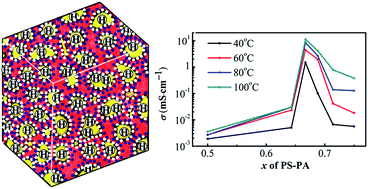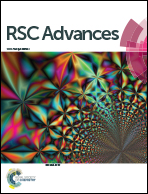Synergetic proton conducting effect in acid–base composite of phosphonic acid functionalized polystyrene and triazolyl functionalized polystyrene†
Abstract
The synergetic proton conducting effect with three orders of magnitude improvement in proton conductivity was observed in an acid–base composite composed of phosphonic acid functionalized polystyrene (PS-PA) and triazolyl functionalized polystyrene (PS-Tri). In addition, a new method for the development of proton conducting materials by the combination of different acidic and basic polymers is proposed. The PS-PA was synthesized by the bromination of polystyrene on the para-position of the phenyl ring followed by phosphonation and hydrolysis. The PS-Tri was synthesized by the chloromethylation of polystyrene on the para-position of the phenyl ring followed by azidation and 1,3-dipolar cycloaddition or ‘click’ reaction. A maximum proton conductivity of 11.2 mS cm−1, which is three orders of magnitude higher than that of pristine PS-PA or PS-Tri, a tensile strength of 16.3 MPa, and a minimum water uptake of 15.1% (90 °C, 90% RH) were observed in the PS-PA/PS-Tri composite composed of 66.7% PS-PA. Finally, a mosaic-like morphology model and space-charge effects were proposed to explain the synergetic proton conducting effect.


 Please wait while we load your content...
Please wait while we load your content...